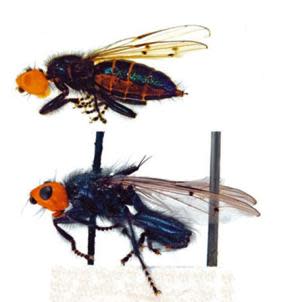 Science and Weather
Science and WeatherA case of mistaken extinction: ‘mythical’ corpse-eating fly returns from the dead

A species of fly thought to have gone extinct over a century ago is back, and not only that, but scientists have actually found three distinct species over the past few years.
This fly, the 'bone-skipper', is known as a corpse-eating fly, as it prefers to dine on large dead animals (including humans) that are in advanced stages of decomposition. They earned their name, though, from both their 'specialty' of going after the bone marrow of these large animals (to feed and to breed), and from the curling and uncurling motions their larvae make as they move along a corpse, which makes it look like they're skipping.
[ Related: One in eight bird species are at threat of extinction ]
One particularly curious aspect of them, which no-doubt added to their 'mythical' status, was that their bright orange heads were said to glow in the dark.
They were last seen (by human eyes, at least) in 1849, and afterward they were declared extinct. Their supposed disappearance was blamed on human activity, but in an interesting twist on human-caused extinctions, it was actually due to a change in our habits towards being cleaner and more responsible.
Around the time they disappeared, society was going through a change, with different agricultural practices becoming more commonplace, especially with better efforts to dispose of the carcasses of slaughtered animals. This removed the flies' main source of food, at least the sources near where we could see them.
One of the problems that contributed to their 'extinction', though, was the lack of taxonomy. Identifying any species (plant, animal, insect, etc) depends on having good records to compare specimens to. As Pierfilippo Cerretti, a researcher at the Sapienza University of Rome, told LiveScience, the taxonomy of these flies "was almost completely incorrect — a mess."
"If you have no good specimens, you have no good taxonomy," he said.
The research efforts of Cerretti and his colleagues were recently published, establishing a 'neotype' for the species. This will define one specific species, Centrophlebomyia anthropophaga, as the basis to compare all species of this type of fly against, and prevent it from accidentally being misplaced again.
[ More Geekquinox: Alberta flood waters recede, but what’s left behind may be worse ]
This isn't the only species to be 'rediscovered'. Around two years ago, the Borneo rainbow toad was reported found again after 87 years on the 'extinct' list. That's not the only one, though, as there have been several examples of these kinds of rediscoveries over the years. There have even been animals on the extinction list that never even existed in the first place.
(Image courtesy: Daniel Martin-Vega/Systematic Entomology)
Geek out with the latest in science and weather.
Follow @ygeekquinox on Twitter!


